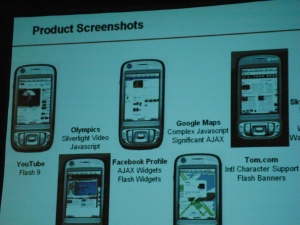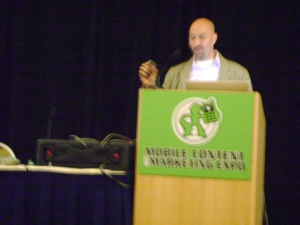From Mobile Content & Marketing Expo
San Jose, CA–Moderated by Skyfire‘s Ray Singh, QuickPlay‘s Mark Hyland, thePlatform (Comcast subsidiary) Chris Drake, GoldSpot Media‘s William Ganon and MobiTV‘s Kevin Grant discussed the state of mobile TV.

Mark Hyland (L), Chris Drake (C), William Ganon (R)
Singh suggested that there are numerous definitions for mobile TV, and asked Hyland what is definition is. Hyland broke it down into true broadcast and IP. “We see activity in all those things,” he said. “There has to be a sensible user experience. There’s an essence of content we’re all working for: it has more to do with communication. VOD, getting what you want when you want it, recommended by friends, is probably a pretty good way to work with mobile video today.”
Kytetv and mywaves are two ways that people are using to publish their own video, said Skyfire’s Singh. Why hasn’t that been [more] successful? Drake said that “we’ve limited mobile to just mobile.” “We’re seeing trends that content providers and media companies are thinking more holistically,” he said. “Yes, there are a lot of technology limitations, but it has to do with consumer awareness and accessibility. We’re starting to see more cross-promotion about what’s unique. It’s complementary to the website,”
If you look at the video space today, there’s content that people pay for, subscribe to and get for free. Is mobile advertising working? “I think mobile video advertising is starting to make its way into the mind of the consumer,” said Ganon. “It’ll probably be linked to whether the user thinks they’re getting value. There’s really not any one player that can do it all, but if operators can be flexible with their pricing scheme. If technologists can deliver a high quality experience, yeah, mobile has a really good future.”
How do you track engagement and what is a click through, asked Singh. Hyland said it was initially all downloads of premium video. “It took you two minutes to download and the operator would charge you $2, but early adopters did it,” he said. “As prices got cheaper and content got better…that’s an acid test. Then we moved into a subscription or streaming model, often bundled with a data plan. Essentially, instead of a nickel and dime model, it’s all you can eat. And we saw service explode with that. We see anywhere from one-quarter to one-half on any service engaging with us, and that’s an important metric. If they go south, that means they’re not getting value.”
Drake addressed the earlier question of what mobile video is. “We’ve seen a shift in the definition,” he said. “It was mainly streaming and occasionally downloading. But a lot of those variables have changed and so have the mobile phones. It could be a phone, an iPod Touch, etc. Content delivery has also changed and addresses some of the clogged network issues. This is still so early now and a lot of these issues and limitations are based on today’s levels, which will hopefully go away. We saw the same issues with broadband in the 1980s.”
Returning to the topic of advertising, he addressed GoldSpot Media’s Ganon. “There is no greater difference in a business than between zero and a penny,” he said. “The fact that people can look for content in an untethered environment – then we’ll see how much hours people watch, what shows they watch. The minute they know they have a $20/month pre-charge, it’s not a great landscape for television, The more free content we can get out, the more we inculcate people with the notion of watching video on the mobile.”
If you look at your TV at home, very few cable providers are offering it for free, pointed out MobiTV’s Grant. That business has been around for a long time. “I don’t think the ad budgets will triple,” he said. “These guys will still have a limited amount to spend, and we all have to cut into it.” Does MobiTV become an HBO? “What MobiTV does is we definitely use what we can out of the advertising space to subsidize the technology to make it work,” said Grant. “You don’t forkload mobile video on a mobile network without spending a big piece of cash. There’s a happy medium: you make free content available so people know it’s there, and you subsidize it with advertising. And you make premium content available for more. Advertisers can’t pay it all. From an ad perspective, it’s a miracle, because you know they’re watching the video when they’re watching video on the phone. We know they’re turning it off on their own. It’s compelling eyeballs. So we maximize the advertising spend to help the content providers and companies like us. But I don’t think it’ll be free, everywhere.”
Long-tail content hasn’t been a big player in the mobile space, noted Hyland. “We’ve been working with producers of Hispanic content, religious content–avid audiences but not big enough to make it on a carrier’s deck,” he said. “You have to blur the lines between on-deck and off-deck, so you can find it. But now it’s naturally skewed towards higher-end content.”
Mobisodes was a stage in the development of mobile content, observed Drake, on the way to developing made-for-mobile content. “We learned you can’t make programming from the footage left on the cutting room floor,” he said. “You have to take into consideration the consumer, where he is, what his user profile is. We’re seeing interesting things with our customers. CBSNews is doing a lot with consumer journalism, for example. The paradigm shift is changing from one-to-many to many-to-many, with users sharing content, tagging it.”
Talking about mobile ads, Ganon noted the general consensus that 30-seconds is a little too long. “If we don’t bring an interesting solution to this game, we can just forget about it,” he said. “If you make targeted TV, that’s an interesting discussion. The mobile audience has no tolerance for the ad-roll.”
MobiTV’s Grant noted that he’s seeing the minutes that customers are watching grow at a much greater rate than the number of new customers, especially election and financial news. “They’re aware of the fact that they have this on their phone,” he said. “The fact that the minutes are growing is good across the board. News has been amazing lately. You don’t see a debate double our minutes. The size of the minutes is so large it would take a pretty big feed to double the minutes. The Olympics is the Holy Grail of content, but that was a unique channel and it did really really well, but it didn’t necessarily double our minutes. All boats are rising. The long-tail is so important. You need the big brands, and long-form like “Ugly Betty” does very well. A lot of people in our base are religiously watching these things. We haven’t opened up the YouTube library or mywaves, because we work with carriers and their restrictions. But big brands bring them in and long-tail reduces churn and keeps them there.”
Hyland reported that we’ll see numerous different models for introducing and paying for video; handset manufacturers will subsidize some of it. “Awareness and pricing are two big barriers to mobile adoption, but there’s a lot of opportunities to package it up differently,” he said. “If you can package video with the phone, it’ll make much higher usage. The day pass or the “free previews and sign up for 20 clips” will be two of those models. Lots of experimentation and no answers formed yet.”
Singh asked panelists to describe what people are watching. Ganon said he worked at MediaFLO and “if it’s live, breaking now” it’s big; sports seems to be a big draw, if you can get the access/rights. “We had experiments where people were watching movie,” he said. With the iPhone, we hear that people are sitting and browsing for an hour, said Singh, who asked if people are really watching movies on the mobile phone. “It’s difficult for me to comment but anecdotally we see different levels and types of usage depending on how the user is discovering and accessing that content,” said Drake. “We’re seeing content that’s being side-loaded which gives a better user experience. We’re seeing long-tail video like a Homer Simpson video. Then there’s the discovery around genre-based content. The ability to set content alerts is also at work.”
The iPhone has done a lot to let people know that they can go on the Internet. “We’re seeing an awareness factor,” said Grant. “We’ll start to see some big numbers.” Singh finally asked: what’s your favorite mobile TV show and what do you see in the future?
Chris Drake said he loves Sony Pictures Television International‘s minisodes, which creates 5-minute versions of classic TV shows. Hyland likes “Entourage” on mobile. Ganon, who watches YouTube, thinks the DTV transition will be a game-changer. Grant says his favorite show is “The Office” and CNBC on mobile.
“If you look at access to the Internet, alot of it will be wireless in a little while,” he said. “And that’s where we see huge opportunities for growth, with all kinds of mobile devices. We’re very keen on this market but it’s a long term battle.”
 episodes directly to their handheld devices.Showtime also launched its password-protected website, developed with online video platform Brightcove, allowing voters to mark their ballots online.
episodes directly to their handheld devices.Showtime also launched its password-protected website, developed with online video platform Brightcove, allowing voters to mark their ballots online.




















